10 June—02 July 2021
Online
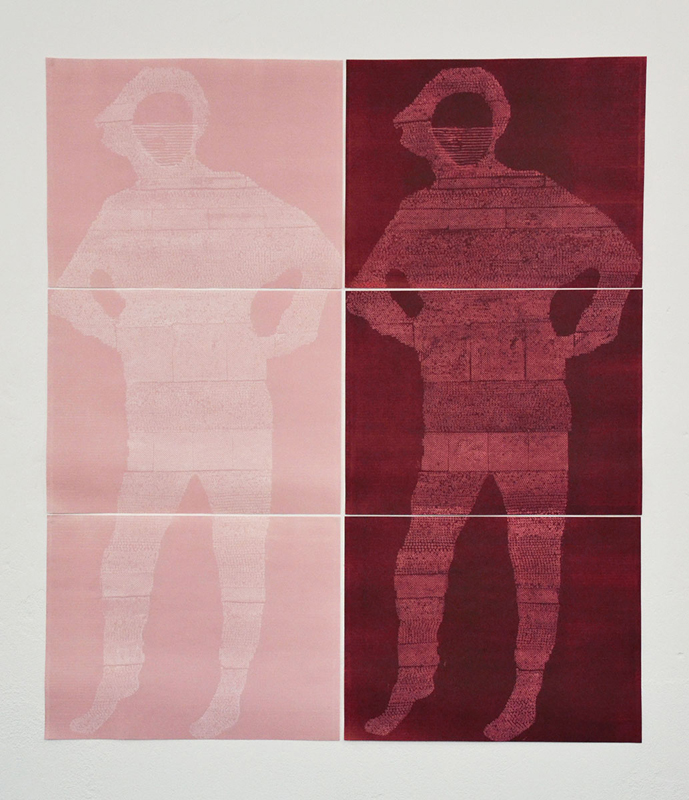
Katarzyna Zimna, Love is patient, 2021, relief print and collagraph on filter paper, 150 cm x 132 cm, signed by the artist
Price on request by emailing info@almanacprojects.com
‘Love is patient, love is kind. It does not envy, it does not boast, it is not proud. {…}
Love does not delight in evil but rejoices with the truth. {…}
It always protects, always trusts, always hopes, always perseveres.’
St. Paul, First Letter to the Corinthians Chapter 13
As the fifth correspondent for Love Letters, Astrid Korporaal and Basia Sliwinska invite Katarzyna Zimna. Support the All-Poland Women’s strike by purchasing the editions, and the artists through their works (by emailing info@almanacprojects.com).

from the left:
Love is blind (black), 2021, relief print on filter paper, 66 x 50 cm;
Love is blind (red), 2021, relief print on filter paper, 66 x 50 cm. Both signed by the artist.
Price on request by emailing info@almanacprojects.com
Sacrifice rituals accentuate the powerful social mechanisms that shape normative gender roles and maintain patriarchal practices. These rituals are particularly visible in patriarchal institutions such as the Catholic Church, which in countries such as Poland, became intertwined with the State via the signing of a Concordat with the Vatican in 1993. The Church’s approach to life and traditional family manufactures an oppressive and violating bodily politics, pathologising any gender or sexual identity that does not fit the normative heterosexual matrix. Its discursive imaginations of female identity construct her as a self-sacrificing woman. Everyday rituals that are embedded within family structures continue to legitimise the male-dominated social order. The accepted Catholic model of femininity regulates women’s bodies based on the triangulated axis of mother, saint and martyr. This triangle translates into values such as obedience, chastity and submission. The woman is disciplined into being patient and kind, always trusting and hopeful, always persevering and caring for others. Her life and body are regulated to mirror the trope of Virgin Mary, a subordinate, passive, pure and obedient servant trapped in the sphere of domesticity.
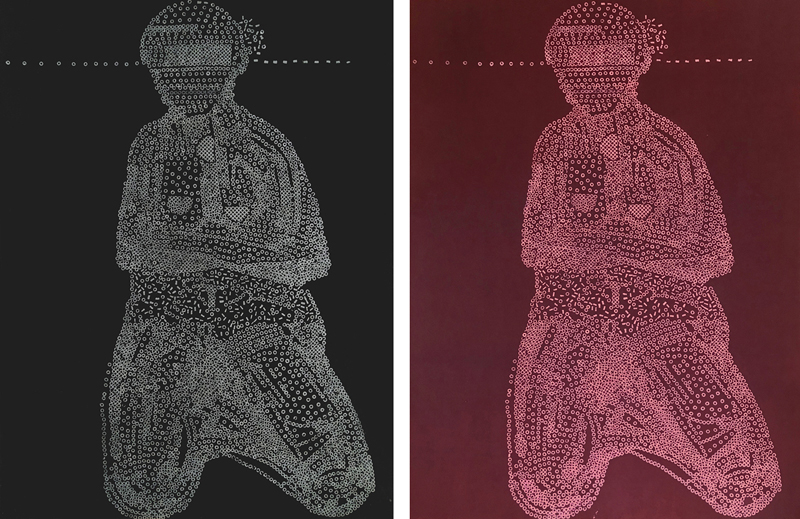
from the left:
Love is deaf (black), 2021, relief print on filter paper, 66 x 50 cm;
Love is deaf (red), 2021, relief print on filter paper, 66 x 50 cm. Both signed by the artist.
Price on request by emailing info@almanacprojects.com
With these works, Katarzyna Zimna joins the women’s struggle for women’s bodily autonomy and agency. The titles of her 2021 graphic series – Love is blind; Love is patient; Love is deaf; Love is mute – are a direct reference to St. Paul’s First Letter to the Corinthians. In an act of resistance, these works juxtapose love, which according to bell hooks (1994) is a practice of freedom with a transformative potential ‘against domination, against oppression’, with the Christian model of blind, patient, enduring, mute and deaf femininity. Zimna rejects this pure and immaculate notion of femininity and makes visible the violence and victimisation embodied in its patriarchal origins. The titles provoke us to engage in a conversation on the notions of love and freedom: love without submission.

from the left:
Love is deaf (black), 2021, relief print on filter paper, 66 x 50 cm;
Love is deaf (red), 2021, relief print on filter paper, 66 x 50 cm. Both signed by the artist.
Price on request by emailing info@almanacprojects.com
With these works, Katarzyna Zimna joins the women’s struggle for women’s bodily autonomy and agency. The titles of her 2021 graphic series – Love is blind; Love is patient; Love is deaf; Love is mute – are a direct reference to St. Paul’s First Letter to the Corinthians. In an act of resistance, these works juxtapose love, which according to bell hooks (1994) is a practice of freedom with a transformative potential ‘against domination, against oppression’, with the Christian model of blind, patient, enduring, mute and deaf femininity. Zimna rejects this pure and immaculate notion of femininity and makes visible the violence and victimisation embodied in its patriarchal origins. The titles provoke us to engage in a conversation on the notions of love and freedom: love without submission.
Zimna practises, literally and metaphorically via the print medium, love as the nurturing of one’s own and another’s growth. The artist engages in a ritual of printmaking, a process of devotion and care, to intervene into degrading gender roles and make a record of stigmatised female subjects silenced to protect the male perpetrators. Her prints activate thinking concerning women’s errant status and the urgency to reclaim not only bodily autonomy but affirm female subjectivity through love. Her relief print entitled for my daughters (an edition to be printed with love on request) is a powerful act of reclaiming women’s agency by combining the roles of mother, carer and maker. Love, if brought to all encounters and all knowledges, orchestrates generous plurivocal relationships beyond the isolated individual and towards the commons. Such communal practices cultivate micro- and macrocosms founded upon listening to oneself and the other; on awakening, caring and healing.
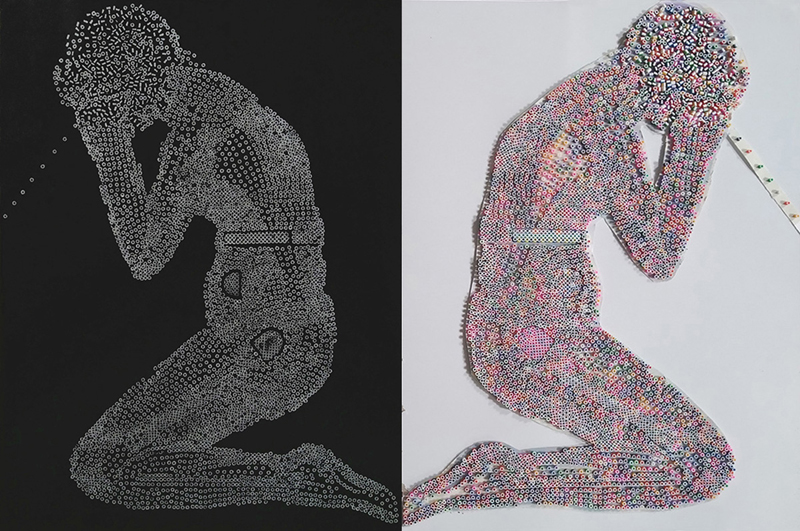
Love is blind, 2021, a print and a matrix
Loving care and patience overarches Zimna’s printing practice. Printmaking is often negatively classified as a reproductive discipline of creativity, and associated with feminine domestic arts. Zimna explores the capacity of printmaking to orchestrate women’s community-building against the denigration of womxn-centered activities. Making prints requires care, attention and patience, which in this context can be translated into perseverance, strength and survival. Zimna resists the Christian discipline of the female body, which in theory can be virtuous but is also often pathologised. Her attention to the matrix, the primary element of the printmaking process, raises questions around visibility of labour and care involved in the production of an image. Symbolically, she also pays tribute to the unacknowledged affective and care labour performed daily in domestic spaces and beyond.
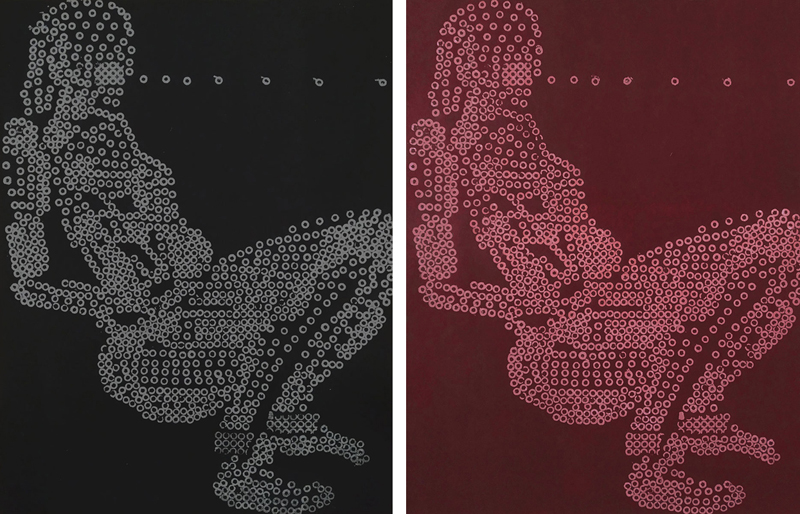
from the left:
Love is mute (black), 2021, relief print on filter paper, 33 x 25 cm;
Love is mute (red), 2021, relief print on filter paper, 33 x 25 cm; Both signed by the artist.
Edition: to be printed with love on request, please be aware that each copy is hand printed, so they are not 100% identical.
(40 pounds + postage and shipping)
The palimpsestic nature of print manifests itself in the layers and surfaces that are relational, not revealing complete information about the image that emerges through an entangled sequence between fragments. Multiplication, inherent in printmaking, emphasises issues of participation, democracy, and reproduction. Matrix, meaning ‘womb’ in Latin, has direct connotations with the female body and reproduction. Intimate and private, usually the matrix is not displayed to the audience who views the outcome of the printmaking process. Zimna makes the matrix visible to us, generously revealing that which is secretive and private. Working on a matrix is one of the daily duties she performs alongside domestic labour and childcare. She created the matrix for this series from beads that her daughters use to make small figurines. The beads act as analogue pixels: metaphorically signifying ways in which images are composed and complicating the notion of re-presentation.
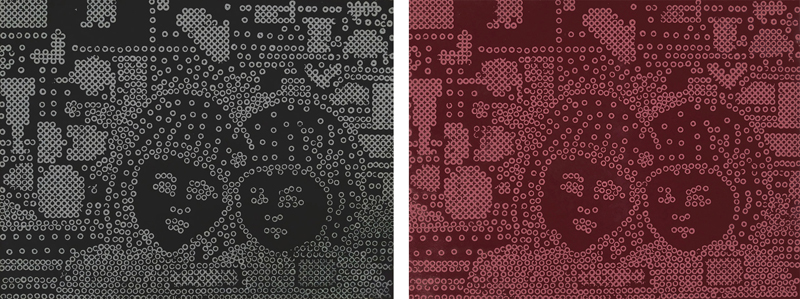
from the left:
for my daughters (black), 2021, relief print on filter paper, 25 x 33 cm;
for my daughters (red), 2021, relief print on filter paper, 25 x 33 cm; Both signed by the artist.
Edition: to be printed with love on request, please be aware that each copy is hand printed, so they are not 100% identical.
(40 pounds + postage and shipping)
Zimna’s experimentation with printmaking as an inter-medium is performative, enabling her to engage with different media and test the potentials of versatile methods of working. The circular beads she uses allude to the circular structures characterising many womxn’s practices and central to feminist epistemologies. With no beginning and end, the circle is both a temporal and spatial marking of the affective and tactile qualities of processes. When we look at the prints, we can notice the traces of the artist's activities and engage with the creative process embodied within these imprints. Each piece comes with a story that Zimna invites us to join, and to ponder on our practice of love – and its place within the matrix of interpersonal relationships. Does our love entail mutual recognition and respect towards the self and the other, and subjective and bodily agency?
Rather than giving us images as icons of self-sacrifice, for womxn to be compared to and asked to subject themselves to, Zimna gives us images that can be looked through. Each circle, drawn from the imprint of an individual bead, contains its own space of potential. Many of her images also come to us as pairs, as companions traced from a similar intention but unique in its expression. These figures are not mirrors for us to compare ourselves to or within which to analyse our flaws. They are spaces of similarity and difference, for the celebration of plurality. Through these works patience of bearing suffering becomes transformed into the patience of weaving new futures. This is a process that carries the work of many hands: those who make the beads, who handle the beads, who trace the beads and who project their imaginations onto the constellations they form.
Bio
Katarzyna Zimna is an artist and researcher living and working in Łódź, Poland. Graduated from the Academy of Fine Arts and Design in Łódź in 2002. PhD from the School of Art and Design, Loughborough University, UK in 2010. Habilitation in Fine Arts in 2019. Author of Time to Play. Action and Interaction in Contemporary Art (I.B. Tauris, 2014/ Bloomsbury 2020). Since 2011 Adjunct Professor at the Institute of Architecture of Textiles at the Łódź University of Technology.
Participant in numerous group and juried shows in Poland and abroad, printmaking biennials and triennials – i.e. in Łódź, Jelenia Góra, Kraków, Olsztyn, Gniezno (Poland), Cacak (Serbia), Santander (Spain), Yogyakarta (Indonesia), Douro (Portugal), Split (Croatia), Varna (Bulgaria), Brugge (Belgium), Quebec (Canada), Lahti (Finland), Sophia (Bulgaria). Author of 16 solo shows, participant of IMPACT International Multidisciplinary Printmaking Conferences in Hangzhou 2015, Santander 2018 and Hongkong 2021 and the Paradox European Biennial Art Forum in Riga (Latvia) in 2019.
Her practice, using as a main vehicle the printmaking medium, is fuelled by the 'anatomy' of print. The matrix, the print substrate, the process of printing, the final printout and lastly the 'post-print' area, including the relationship with the viewer, become starting points for formal and conceptual journeys. She often explores the issues of feminine values and identities, inspired by her everyday roles and chores, growing the garden and raising two daughters.
www.kasiazimna.net